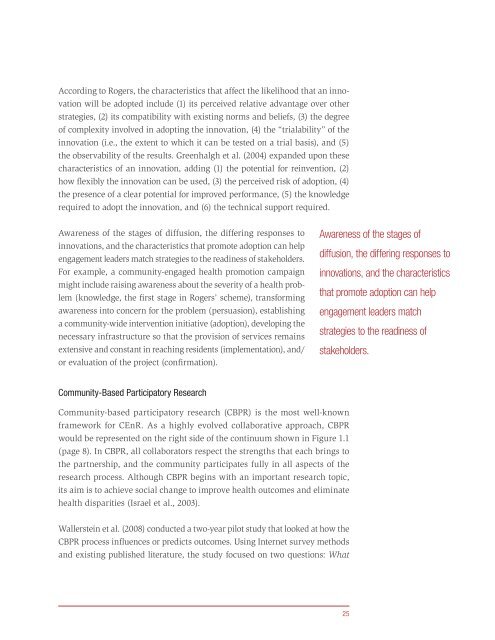Principles of Community Engagement (Second Edition)
Principles of Community Engagement (Second Edition)
Principles of Community Engagement (Second Edition)
Create successful ePaper yourself
Turn your PDF publications into a flip-book with our unique Google optimized e-Paper software.
According to Rogers, the characteristics that affect the likelihood that an inno-<br />
vation will be adopted include (1) its perceived relative advantage over other<br />
strategies, (2) its compatibility with existing norms and beliefs, (3) the degree<br />
<strong>of</strong> complexity involved in adopting the innovation, (4) the “trialability” <strong>of</strong> the<br />
innovation (i e , the extent to which it can be tested on a trial basis), and (5)<br />
the observability <strong>of</strong> the results Greenhalgh et al (2004) expanded upon these<br />
characteristics <strong>of</strong> an innovation, adding (1) the potential for reinvention, (2)<br />
how flexibly the innovation can be used, (3) the perceived risk <strong>of</strong> adoption, (4)<br />
the presence <strong>of</strong> a clear potential for improved performance, (5) the knowledge<br />
required to adopt the innovation, and (6) the technical support required<br />
Awareness <strong>of</strong> the stages <strong>of</strong> diffusion, the differing responses to<br />
innovations, and the characteristics that promote adoption can help<br />
engagement leaders match strategies to the readiness <strong>of</strong> stakeholders<br />
For example, a community-engaged health promotion campaign<br />
might include raising awareness about the severity <strong>of</strong> a health problem<br />
(knowledge, the first stage in Rogers’ scheme), transforming<br />
awareness into concern for the problem (persuasion), establishing<br />
a community-wide intervention initiative (adoption), developing the<br />
necessary infrastructure so that the provision <strong>of</strong> services remains<br />
extensive and constant in reaching residents (implementation), and/<br />
or evaluation <strong>of</strong> the project (confirmation)<br />
<strong>Community</strong>-Based Participatory Research<br />
<strong>Community</strong>-based participatory research (CBPR) is the most well-known<br />
framework for CEnR As a highly evolved collaborative approach, CBPR<br />
would be represented on the right side <strong>of</strong> the continuum shown in Figure 1 1<br />
(page 8) In CBPR, all collaborators respect the strengths that each brings to<br />
the partnership, and the community participates fully in all aspects <strong>of</strong> the<br />
research process Although CBPR begins with an important research topic,<br />
its aim is to achieve social change to improve health outcomes and eliminate<br />
health disparities (Israel et al , 2003)<br />
Wallerstein et al (2008) conducted a two-year pilot study that looked at how the<br />
CBPR process influences or predicts outcomes Using Internet survey methods<br />
and existing published literature, the study focused on two questions: What<br />
Awareness <strong>of</strong> the stages <strong>of</strong><br />
diffusion, the differing responses to<br />
innovations, and the characteristics<br />
that promote adoption can help<br />
engagement leaders match<br />
strategies to the readiness <strong>of</strong><br />
stakeholders.<br />
25

















